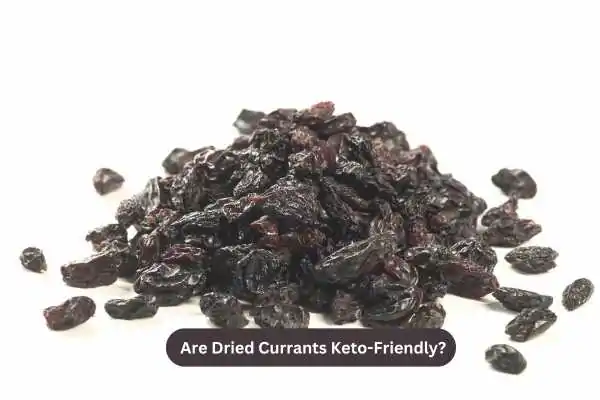The ketogenic diet, or keto for short, has gained a strong following in the UK for its potential to support weight loss, improve mental clarity, and promote stable energy levels. Central to the diet is the principle of limiting carbohydrate intake, typically to around 20–50 grams of net carbs per day, to encourage the body to enter ketosis—a metabolic state where fat becomes the primary fuel source.

For anyone on a keto diet, understanding which foods fit within these carb limits is crucial. While fresh fruits are often limited due to their natural sugar content, dried fruits can be even trickier to navigate. In this article, we’ll take a close look at dried currants and see whether they have a place in a keto lifestyle.
What Are Dried Currants?
Dried currants are small, seedless raisins typically made from the Black Corinth grape. They are not the same as fresh currants (red, black, or white berries), although both share a tart-sweet flavour. These tiny fruits are dried to concentrate their sweetness, making them a popular addition to baked goods, cereals, and snack mixes.
Because the drying process removes water and concentrates natural sugars, dried currants are significantly higher in carbohydrates by weight compared to their fresh counterparts. This fact alone raises questions about whether they can fit into a keto plan.
Nutritional Profile of Dried Currants
On average, a 28-gram (1-ounce) serving of dried currants contains:
-
Calories: ~80–90
-
Total Carbohydrates: ~21 g
-
Fibre: ~2 g
-
Net Carbs: ~19 g
-
Protein: ~1 g
-
Fat: 0 g
The high carbohydrate count—mostly from natural sugars—means that even a small serving can take up a large portion of your daily keto carb allowance.
Are Dried Currants Keto-Friendly?
In strict keto terms, dried currants are not generally considered keto-friendly due to their high net carb content. Even a small handful can easily exceed half of your daily carb limit, making it harder to stay in ketosis.
However, whether you can enjoy them occasionally depends on your personal carb tolerance and goals. Some people following a more liberal low-carb diet (50–100 g net carbs per day) might be able to fit in small amounts without affecting their progress.
For those aiming to remain in deep ketosis, dried currants are best avoided or used only as a rare garnish rather than a snack.
Why Dried Currants Are High in Carbs
The main reason dried currants have such a concentrated carb load is the drying process. When water is removed, the sugars and carbohydrates are condensed into a smaller volume. What would be a large serving of fresh grapes becomes a small handful of dried fruit, but with nearly all the same sugar content intact.
This is why many dried fruits, including raisins, dates, and figs, are generally avoided on keto.
Possible Ways to Include Dried Currants in a Low-Carb Diet
If you enjoy the taste of dried currants and want to include them occasionally, here are some strategies:
-
Use them sparingly in recipes – A teaspoon or two sprinkled into a keto-friendly salad or coleslaw can provide a burst of flavour without adding too many carbs.
-
Pair them with high-fat foods – Combining a very small amount of dried currants with nuts, seeds, or cheese can help slow the absorption of sugars.
-
Plan your carb intake – If you know you’ll be having currants, reduce carbs from other meals that day to stay within your limit.
Keto-Friendly Alternatives to Dried Currants
If you’re looking for a sweet-tart flavour similar to currants but with fewer carbs, consider:
-
Fresh raspberries – Lower in carbs and rich in fibre.
-
Cranberries (unsweetened) – Can be chopped and used sparingly.
-
Blackberries – Provide a similar tang and can be enjoyed in moderation.
These alternatives allow you to enjoy fruit flavours without exceeding your carb limit.
Health Benefits of Dried Currants (Outside Keto)
While they may not be ideal for strict keto, dried currants are still a nutrient-dense food. They contain:
-
Antioxidants – Help protect against oxidative stress.
-
Iron – Supports healthy blood production.
-
Fibre – Aids digestion and promotes satiety.
These benefits are valuable for those on more moderate eating plans, but on keto, the carb count remains the limiting factor.
Final Verdict
For most people following a ketogenic diet in the UK, dried currants are too high in net carbs to be eaten regularly. Their concentrated sugar content makes it challenging to stay within strict carb limits while enjoying them in more than tiny amounts.
If you love the taste of currants, you can still experiment with micro-portions as part of a carefully planned low-carb meal. Otherwise, consider keto-friendly berry options that deliver sweetness, tang, and nutrients with a much lower carb load.
By understanding their nutritional profile and carb impact, you can make informed choices that align with your dietary goals—ensuring you stay on track while still enjoying your food.

